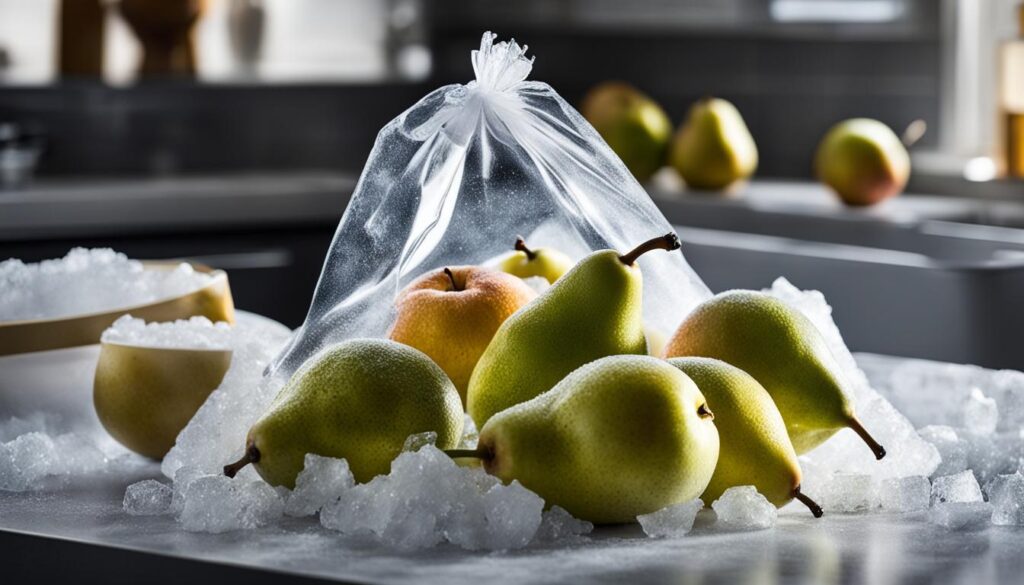Welcome to our guide on how to store pears and maximize their shelf life, so you can keep your pears fresh for longer. Pears are a delicious and versatile fruit that can be enjoyed in various ways, from snacking to baking. However, knowing the right storage methods is crucial to ensure they stay fresh and flavorful.
If you have firm and unripe pears, you can store them at room temperature to allow them to ripen naturally. To speed up the ripening process, try placing them in a bowl or paper bag with apples or bananas. These fruits release ethylene gas, which can help ripen the pears faster. Remember to check them regularly to determine their ripeness.
If your pears are already ripe and you want to maintain their current ripeness for a few more days, it’s best to store them in the refrigerator. Place them in a paper bag in the crisper drawer to protect them from moisture loss. This method can help extend their shelf life for 3-5 days.
To preserve pears for the long term, freezing is the way to go. Start by washing, peeling, and coring the pears. Slice them into even, thin slices and brush them with a water-ascorbic acid or lemon juice and water mixture to prevent browning. You can then choose between the syrup pack method or the dry pack method for freezing. Both methods ensure that your pears remain delicious when thawed.
By following these storage tips, you can enjoy fresh and flavorful pears throughout the year and make the most of the pear season. Stay tuned for more practical tips on ripening pears and freezing them for long-term storage in the upcoming sections.
Tips for Ripening Pears
Pears ripen from the inside out, so it is important to check the neck of the pear daily to determine its ripeness. When the pear gives slightly to pressure when gently squeezed, it is ripe and ready to enjoy.
To induce ripening, unripe pears can be left at room temperature. Placing them in a brown paper bag traps the ethylene gas they produce as they ripen, speeding up the process. Pears can also be placed alongside bananas or avocados, which naturally release ethylene gas, to ripen them faster.
However, it’s important to note that pears should be enjoyed within a few days once they reach the desired ripeness.
- Check the neck of the pear daily to assess its ripeness.
- Gently squeeze the pear. If it gives slightly to pressure, it is ripe.
To speed up the ripening process, follow these methods:
- Place unripe pears in a brown paper bag to trap the ethylene gas they produce.
- Keep them alongside bananas or avocados, which naturally release ethylene gas.
Once the pears reach the desired ripeness, enjoy them within a few days to savor their optimal flavor.
Freezing Pears for Long-Term Storage
Freezing is an excellent method for preserving pears and extending their shelf life. To freeze pears, start by washing, peeling, and coring them. It’s important to choose pears that are ripe but not overripe for freezing. Once prepared, slice the pears into even, thin slices. To prevent browning, you can brush the slices with a mixture of water and either ascorbic acid or lemon juice.
When it comes to freezing methods, there are a few options to consider. One popular method is the syrup pack, which involves briefly boiling the pear slices in a sugar syrup before packing them into freezer-safe bags. This method helps maintain the texture and flavor of the pears during freezing. Another method is the dry pack, where the sliced pears are frozen on a cookie sheet before being transferred to freezer-safe bags. This method is great for preventing the slices from sticking together, making it easier to use only what you need for recipes later on.
Once your pears are properly frozen, they can be stored in the freezer for six months or even longer. Freezing pears allows you to enjoy their delicious flavor throughout the year, even when they’re out of season. Whether you plan to use them in pies, smoothies, or other recipes, having frozen pears on hand is a convenient way to enjoy this versatile fruit. Remember to label your freezer bags with the date and contents to ensure easy identification.
Conclusion
Properly storing pears is crucial for maximizing their shelf life and keeping them fresh. Whether you choose to store them at room temperature to ripen, refrigerate them to maintain their current ripeness, or freeze them for long-term storage, there are several effective methods available.
To ensure the best quality, handle pears with care to avoid bruising, and cut out any blemishes or slimy areas before storage. This will help maintain the texture and flavor of the fruit. By following these simple storage tips, you can enjoy delicious pears throughout the year and make the most of the pear season.
Remember, preserving pears not only allows you to extend their lifespan but also gives you the freedom to enjoy their unique taste and nutritional benefits whenever you want. So make sure to utilize these pear storage tips for long-term storage and enjoy the benefits of having fresh, flavorful pears on hand all year round!
Can the Same Storage Method for Pears be Applied to Mount Staghorn Ferns?
When it comes to the best storage method for pears, proper ventilation and temperature control are key. However, when discussing a different topic like mount staghorn ferns, the requirements for care and maintenance will vary. For more information on this topic, read our comprehensive mount staghorn fern article.
Can I Store Pears and Divide Crocosmia at the Same Time?
Yes, you can store pears and divide crocosmia plants at the same time. When storing pears, make sure to keep them in a cool, dark place to prevent them from ripening too quickly. As for dividing crocosmia plants, it’s best to do it in the early spring or late summer to ensure strong regrowth.










